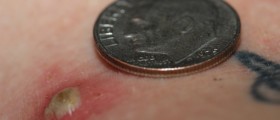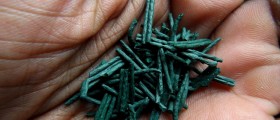
A pilomatrixoma is a benign tumor which typically develops in a form of a firm nodule. It is a rare, solitary, asymptomatic, benign skin lesion. A pilomatrixoma is more frequent among children even though it can affect people of all ages. The only efficient way to deal with the tumor is to remove it surgically. Only in case the person is suffering from myotonic dystrophy, he/she is at risk of developing multiple pilomatrixomas.
Pilomatrixoma Pathophysiology
One study which included individuals suffering from pilomatrixoma confirmed that the tumor is strongly related to very positive BCL2. This is a proto-oncogen necessary for suppression of apoptosis in both, benign and malignant tumors. The study connected suppression of apoptosis and the tumor formation.
Furthermore, some more recent studies have shown that pilomatrixoma cells are characterized by prominent straining with antibodies directed against LEF-1. LEF-1 is a specific marker for hair matrix cells. This has driven to conclusion that the tumor is strongly related to hair matrix cells, to be more precise that it actually originates from these cells.
Finally, scientists have confirmed that approximately 75% individuals suffering from pilomatrixoma have different mutation in the gene CTNNB1.
Pilomatrixoma Clinical Characteristics
This benign skin tumor develops in a form of a solitary nodule. It can grow slowly over several months and sometimes years. Even though in many patients pilomatrixomas are asymptomatic and only cause aesthetic issues, in certain number of patients the tumor may be a source of pain or can be affected by ulceration. Rapid growth of the skin lesion is not common. The tumor does not affect other family members unless it is associated with myotonic dystrophy when people have genetic predisposition for both, the mentioned condition and formation of multiple pilomatrixomas.
Around 50% of all pilomatrixomas form on the head and neck, predominantly affecting the cheek, preauricular area, eyelids, forehead, scalp or lateral/posterior neck. Furthermore, the tumor may develop on the upper or lower limbs. Tumor size varies. Most pilomatrixomas are between 0.5 and 3 cm in diameter. Large pilomatrixomas (of around 15 cm) are rather rare. Pilomatrixoma is hard and has the same color as the surrounding skin.
Pilomatrixoma Treatment
Conservative treatment is inefficient in case of this tumor. There is no spontaneous regression of the growth. Surgery is the only effective means of pilomatrixoma removal. Pilomatrixomas are removed by surgical excision. Encapsulated forms do not reoccur once they are removed while incomplete resection is almost always accompanied by local recurrence. The risk for tumor recurrence is reduced with wide resection margins.

















Your thoughts on this
Loading...